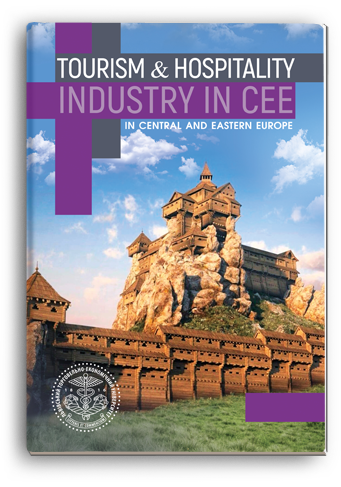Abstract
The main aim of the article is to present an assessment of the dynamics and determine the trends in the tourism development in Łódź and Łódź Voivodeship in 2004-2021, as well as to compare them. Comparison of the tourism development in Łódź and Łódź Voivodeship was carried out on the calculation and analysis of integral indicators. The integral indicator was calculated based on 14 indicators grouped into three groups: 1) tourist accommodation establishments (9 indicators); 2) museums, including branches (3 indicators); 3) organization of mass events (2 indicators). Data collection by groups of indicators was carried out by the statistical observation method. As an information base, it is advisable to use official sources of information, namely data from the official website of Central Statistical Office of Poland and Regional Statistical Office in Łódź. To bring a significant number of different-quality and different-sized analytical indicators of tourism development, which were used to calculate the integral indicator, into a comparable form, they were normalized. Determination of weighting coefficients was carried out by an expert method (ranking method). The analysis allows come to conclusion about presence of common upward trend in the tourism development in Łódź and Łódź Voivodeship with elements of fluctuation in the period of 2004-2019 as well as general dramatic decline in 2020. However, compound annual growth rate of the tourism development in Łódź and Łódź Voivodeship for the analyzed period differs and equals 9,04% and 7,18% respectively. With continued investment in infrastructure, cultural and tourist projects, the region is likely to continue to grow as a popular tourist destination in the coming years. The development of tourism in Łódź and Łódź Voivodeship has been driven by a combination of the following factors: converting a rich history and cultural heritage into cultural and entertainment centers both for tourists and for the locals; significant investment in tourism infrastructure; investing in marketing, advertising and destination management; development of the entertainment industry, etc.
References
Boiko, М., Bosovska, M., Vedmid, N., Melnychenko, S. & Okhrimenko, A. (2017), “Development of the tourism cluster”, Problems and Perspectives in Management, no. 15(4), pp. 134–149, DOI: http://dx.doi.org/10.21511/ppm.15(4).2017.12
Bończak, B. (2013), “The Battle of Łódź 1914: a chance to develop military heritage tourism in the metropolitan tourism region of Łódź”, Tourism, no. 23(1), pp. 17–26, DOI: https://doi.org/10.2478/tour-2013-0002
Cudny, W., Rouba, R. (2012), “The Role of Lodz Festivals in Promoting Adventure Tourism”, Polish Journal of Sport and Tourism, no. 18(4), pp. 264–268, DOI: https://doi.org/10.2478/v10197-011-0021-7
Gorina, G., Bocharova, Y., Kozhukhova, T., Ivanova, N., & Bohatyryova, G. (2022), “The impact of Covid-19 on international trade in tourism services in Europe”, GeoJournal of Tourism and Geosites, no. 43(3), pp. 1091–1098, DOI: https://doi.org/10.30892/gtg.43330-924
Gorina, G., Bohatyryova, G., Nikolaichuk, O., Romanykha, O., Chernega, O., Bocharova, Yu. (Eds.) (2022), “Assessing security and protection in global tourism”, Challenges and paradigm of national and international security of the XXI century: economic and technogenic discourse, РС ТЕСHNOLOGY СЕNTЕR, Kharkiv, Ukraine, pp. 130–148. DOI: https://doi.org/10.15587/978-617-7319-59-6.ch7
Ilieva, L., Bozhinova, M., & Todorova, L. (2021), “A study of the impact of Covid-19 on tourism demand”, International Multidisciplinary Scientific GeoConference Surveying Geology and Mining Ecology Management, SGEM, no. 21(5.1), pp. 321–332, DOI: https://doi.org/10.5593/sgem2021/5.1/s21.074
Jaskulski, M., & Szmidt, A. (2015), “The tourism attractiveness of landforms in Łagiewnicki Forest, Łódź”, Tourism, no. 25(2), pp. 27–35, DOI: https://doi.org/10.1515/tour-2015-0003
Kowalczyk-Anioł, J. (2015), “Tourism development in Łódź in 2000-2014: directions and character of change”, Tourism, no. 25(2), pp. 107–115, DOI: https://doi.org/10.1515/tour-2015-0010
Liszewski, S. (2015), “Tourism studies on Łódź and its metropolitan area”, Tourism, no. 25(2), pp. 11–19, DOI: https://doi.org/10.1515/tour-2015-0001
Liszewski, S. (2009), “Urban ‘tourism exploration space’: the example of Łódź”, Tourism, no. 19(1-2), pp. 57–62, DOI: https://doi.org/10.2478/V10106-009-0007-8
Łódzka Organizacja Turystyczna (2023), available at: https://lodz.travel/en/
Łuć, B. (2021), “Large sports and recreation facilities in the tourism space of Łódź”, StudiaPeriegetica, no. 1(33), pp. 25–40, DOI: https://doi.org/10.5604/01.3001.0014.8876
Naydenov, L. (2022), “Household expenditure during a pandemic: Covid-19 and the case of Bulgaria” Business Management, no. 4, pp. 18–34.
OECD (2014), “Tourism and the Creative Economy, OECD Studies on Tourism, OECD Publishing”, available at: http://surl.li/gnlja
Regional Statistical Office in Łódź (2023), available at: https://lodz.stat.gov.pl/en/
Stasiak, A. (2015), “Gastronomy as a tourism attraction for Łódź”, Tourism, no. 25(2), pp. 73–85, DOI: https://doi.org/10.1515/tour-2015-0007
Statistics of Łódź 2016 (2016), available at: http://surl.li/gnlhl
Statistics of Łódź 2018 (2018), available at: http://surl.li/gnlhq
Statistics of Łódź 2020 (2020), available at: http://surl.li/gnlht
Statistics of Łódź 2022 (2022), available at: http://surl.li/gnlhy
Sushchenko, O., Prokopishyna, O., & Kozubova N. (2018), “Eco-friendly behavior of local population, tourists and companies as a factor of sustainable tourism development”, International Journal of Engineering and Technology (UAE), no. 7 (4.3 Special Issue 3), pp. 514–518.
Sylla, M., Chruściński, J., Drużyńska, P., Płóciennik, P., & Osak, W. (2015), “Opportunities and limitations for MICE tourism development in Łódź”, Tourism, no. 25(2), pp. 117–124, DOI: https://doi.org/10.1515/tour-2015-0011
Trunina, I., Moroz, O., & Herasymchuk, V. (2021), “Implementation of marketing tools in the developvment of industry 4.0”, Proceedings of the 20th IEEE International Conference on Modern Electrical and Energy Systems, MEES 2021, DOI: https://doi.org/10.1109/MEES52427.2021.9598551
Włodarczyk, B. (2016), “Łódź as an arena of grand sport events: selected examples”, Tourism, no. 26(1), pp. 49–59, DOI: https://doi.org/10.1515/tour-2016-0004
Włodarczyk, B. (2019), “Zarys rozwoju turystyki w regionie łódzkim”, Acta Geographica Lodziensia, no. 109, pp. 145–161, DOI: https://doi.org/10.26485/AGL/2019/109/8
UNWTO (2021), “UNWTO Inclusive Recovery Guide – Sociocultural Impacts of Covid-19”, Issue 2: Cultural Tourism, UNWTO, Madrid, Spain. DOI: https://doi.org/10.18111/9789284422579


